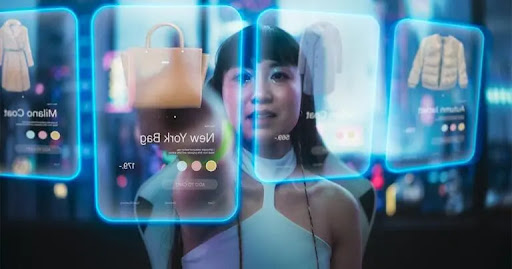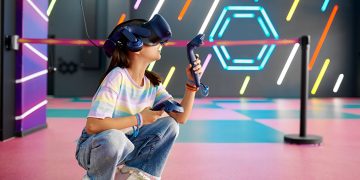Education has always evolved alongside technology, from chalkboards to computers, and now, augmented reality (AR). Today, AR is transforming classrooms, lecture halls, and even remote learning, creating experiences that are interactive, immersive, and highly personalized. Students are no longer passive recipients of knowledge; they actively manipulate, visualize, and experiment within layered realities that blend digital information with the physical world.
Classroom Integration: Case Studies
STEM Learning with 3D Models
In many schools, AR is used to teach complex subjects such as biology, chemistry, and physics. Instead of observing static diagrams in textbooks, students can now interact with 3D models.
Take a high school biology class studying human anatomy. With AR glasses, students can walk around a holographic heart projected in the center of the classroom. They rotate it, zoom into chambers, trace blood flow, and even simulate a heart attack scenario. By interacting with the organ in three dimensions, students gain spatial understanding and retain information more effectively.
Research indicates that AR-enhanced STEM education improves comprehension, critical thinking, and engagement. Traditional lectures often fail to convey spatial relationships or dynamic processes. AR bridges this gap, allowing students to explore phenomena actively rather than passively memorizing facts.
Historical and Cultural Education
AR also enriches humanities education. Imagine walking through a museum or historical site where AR overlays contextual information on artifacts or ruins. Students see animations depicting historical events, biographies of figures, or social interactions from centuries ago.
For example, at an ancient ruins site, students can use AR tablets to visualize reconstructed buildings, witness historical battles unfold, or interact with avatars representing historical figures. This approach fosters empathy, engagement, and a deeper understanding of context. Instead of reading about history, students experience it.
Educational psychologists note that multi-sensory learning enhances memory retention. AR combines visual, auditory, and sometimes tactile stimuli, creating memorable learning experiences that traditional textbooks cannot replicate.
Remote and Distance Learning
AR’s impact extends beyond physical classrooms. During remote learning, students can participate in virtual laboratories and interactive exercises.
A chemistry student at home can safely conduct experiments using AR projections of chemical reactions, controlling variables without risk of spills or explosions. Physics students can manipulate virtual pendulums or circuits, visualizing forces and currents dynamically. This interactive approach mitigates one of the most significant drawbacks of online education: the inability to provide hands-on experience.
Furthermore, AR platforms allow real-time collaboration. Students across the globe can manipulate shared 3D objects, annotate them, and receive immediate feedback from teachers. This connectivity fosters engagement, teamwork, and cross-cultural learning, expanding education beyond local boundaries.
Personalized Learning and Cognitive Benefits
AR enables individualized learning paths. Adaptive AR systems track student performance, identifying areas of difficulty, and providing targeted interventions. For example, a mathematics student struggling with geometry can receive interactive tutorials that adjust in real-time based on their responses and comprehension speed.
Cognitive science research supports this approach. AR facilitates active learning, scaffolding, and experiential engagement. When students can visualize abstract concepts, experiment freely, and receive immediate feedback, their problem-solving skills and conceptual understanding improve significantly.
Additionally, AR can accommodate different learning styles. Visual learners benefit from rich 3D models; kinesthetic learners engage through gesture-based manipulation; auditory learners receive explanations and cues embedded in the experience. The technology becomes an inclusive educational tool, supporting diverse student needs.
Challenges and Considerations
Despite its potential, AR in education faces several challenges:
- Technical Limitations: AR hardware can be expensive, and not all institutions can afford widespread deployment. Battery life, device comfort, and interface design also impact usability.
- Teacher Training: Effective integration requires teachers to understand AR capabilities and pedagogical applications. Professional development and training are essential to avoid using AR as a mere gimmick rather than a transformative tool.
- Cognitive Overload: Excessive or poorly designed AR content can overwhelm students, reducing learning efficiency. Designers must balance immersion with clarity, ensuring that digital layers enhance rather than distract from core concepts.
- Equity and Access: Not all students have equal access to AR technology, potentially widening educational disparities. Policies and investment strategies must ensure inclusivity.

Case Study: Augmented Classrooms in Practice
In a mid-sized urban school district, AR has been implemented in science, history, and vocational training classes. Teachers report higher engagement levels, better retention of information, and increased participation in collaborative projects.
Students describe lessons as “interactive adventures” rather than routine instruction. They can manipulate molecules, reconstruct historical events, or simulate engineering tasks in real-time. Assessments show significant improvements in test scores and conceptual understanding compared to traditional teaching methods.
Moreover, students develop digital literacy alongside subject knowledge. By interacting with AR systems, they learn navigation, interface control, and collaborative digital problem-solving—skills increasingly valuable in modern workplaces.
Future Directions
AR in education continues to evolve:
- Mixed Reality Campuses: Entire classrooms and labs integrated with AR overlays, allowing seamless transition between physical and digital spaces.
- AI-Enhanced AR Tutors: Intelligent systems analyzing student behavior, engagement, and comprehension to provide personalized guidance.
- Global Collaborative Learning: Cross-border projects where students in different countries interact within shared AR environments, fostering intercultural competence and teamwork.
- Gamification and Motivation: Incorporating AR-based games and challenges to motivate students and reinforce learning objectives.
- Integration with STEM and Arts: Expanding AR beyond traditional subjects, allowing creative expression, coding, engineering, and experimentation in immersive contexts.
Social and Cognitive Implications
AR reshapes not only learning outcomes but also social dynamics:
- Students develop stronger collaboration skills through shared AR projects.
- Teachers become facilitators and curators rather than mere instructors.
- Education becomes experiential and exploratory, encouraging curiosity and autonomy.
Cognitively, AR enhances spatial reasoning, memory retention, and problem-solving. The active engagement required in AR learning strengthens neural pathways associated with understanding complex systems and concepts.
However, careful consideration is required. The balance between AR-enhanced engagement and reliance on technology is delicate. Over-dependence may hinder creativity or problem-solving in non-augmented environments. Educators must design AR experiences that complement, not replace, traditional critical thinking skills.
Conclusion: Augmented Reality as a Pedagogical Partner
Augmented reality has emerged as a transformative tool in education. By blending physical and digital worlds, AR enhances understanding, engagement, and collaboration. Students can explore abstract concepts, experience historical events, and conduct safe, interactive experiments—all within immersive environments.
Education with AR is not merely about technology; it is about reshaping cognitive processes, fostering creativity, and cultivating skills for the future. The classroom evolves into a dynamic ecosystem where learning is active, collaborative, and deeply contextual.
As AR continues to mature, it promises to democratize access to high-quality, interactive education, empowering students worldwide to learn in layers, visualize the invisible, and engage with knowledge in ways previously unimaginable.











































